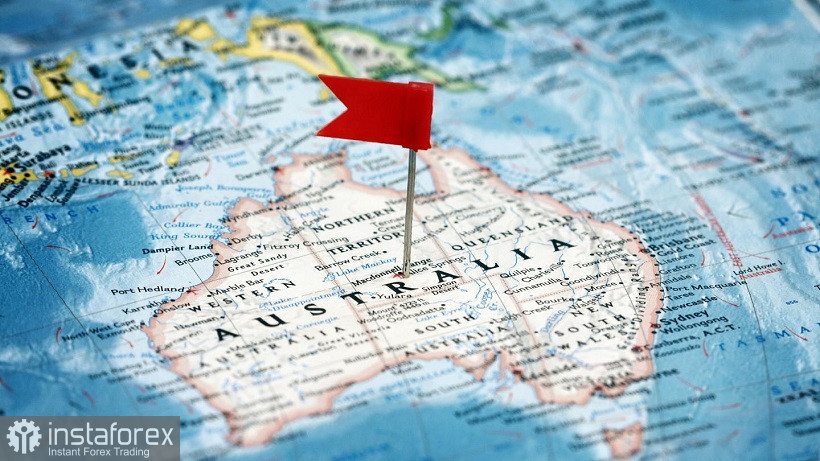The Australian dollar in pair with the US currency hit a local low last Friday, reaching a level of 0.7050. Strong US nonfarm payrolls allowed bears to stage a 100-point southern rally. However, they failed to test the key support at 0.7000. On Monday, the southern momentum ended and then buyers took the initiative. The commodity market also provided support to the aussie: iron ore is rising after a significant decline at the end of last year. The COVID-19 pandemic also favored the Australian dollar. The number of daily new coronavirus cases is gradually declining, while the number of vaccinated citizens is increasing. Australia has announced to reopen its borders amid this news, allowing fully vaccinated tourists to visit the country. However, first things first.
Notably, iron ore is of strategic importance to the Australian economy. This commodity has been considerably declining last year, mainly due to the massive restrictions imposed by China on steel production as part of the country's policy to reduce harmful emissions. Tougher environmental standards have led many Chinese steel mills and steel plants to cut their production. Australia is the world's largest producer of iron ore. So, the country's largest export budget was under threat. For example, in early 2021 the price of a ton of iron ore ranged from $200-220, while in November 2021 the price dropped to $90-100.

China is the world's largest importer of iron ore. The national demand for raw materials is almost 80% covered by imports. In particular, in 2020 China increased the volume of iron ore imports in the country, exceeding the billion ton mark by the end of the year. Australia, accordingly, is China's largest supplier of raw materials. Therefore, the new environmental standards introduced by Beijing hit this sector of the Australian economy hard.
However, this week China has reported that it has made economic growth its priority at the expense of the environment. Beijing has given the country's giant steel industry five extra years to begin curbing its carbon emissions. Following the announcement of the decision, iron ore futures in Singapore were up nearly 4% to $145 a ton, the highest level since late August 2021. Overall, iron ore rose by 70% after hitting a multi-year low last November.
Indirect support for the aussie was also provided by the Australian authorities. They restarted the tourism industry by allowing fully vaccinated travelers to visit the country. Notably, tourism is one of the largest sectors of Australia's economy, accounting for about 3.5%-3.9% of GDP in pre-crisis times. The government closed the border to everyone in March 2020, except Australian citizens and residents. According to many Australian journalists following this topic, the country is expecting a tourism boom after a two-year pause.
All mentioned above factors combined with the general appetite for risky assets, allowed buyers of the AUD/USD pair to regain lost ground. The aussie gained a hundred points in three trading days, reaching the level of 0.7100. Therefore, the Australian dollar leveled Friday's decline. However, the aussie's further growth perspectives will fully depend on the dynamics of the US dollar, which will follow the Treasuries yields.
Currently, the US dollar index stopped rising, anticipating the data on the US inflation growth. This factor is also favorable for bulls in AUD/USD. However, it is impossible to expect the pair's further significant rise. If tomorrow's report is strong, the pair will be under a certain pressure. Therefore, despite favorable news background for the aussie, long positions in the pair are risky. Moreover, the Australian dollar is getting close to the strong resistance level of 0.7180 (lower boundary of the Kumo cloud on the D1 timeframe). An additional information impulse will be necessary to overcome it. Tomorrow's publication may become this impulse, if the US inflation suddenly slows down contrary to numerous forecasts. Therefore, at the moment it is advisable to take a wait-and-see position on the pair, at least till the CPI growth data is released.
According to the technical picture, the pair on the daily chart is on the middle line of the Bollinger Bands indicator, above the Tenkan-sen and Kijun-sen lines, but under the Kumo cloud. In other words, the pair is at a crossroads: the main indicators do not signal about the priority of the north or south direction. Obviously, the US inflation will set the tone of the trades this week.
 English
English 
 Русский
Русский Bahasa Indonesia
Bahasa Indonesia Bahasa Malay
Bahasa Malay ไทย
ไทย Español
Español Deutsch
Deutsch Български
Български Français
Français Tiếng Việt
Tiếng Việt 中文
中文 বাংলা
বাংলা हिन्दी
हिन्दी Čeština
Čeština Українська
Українська Română
Română

